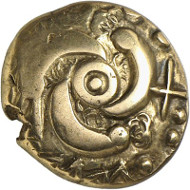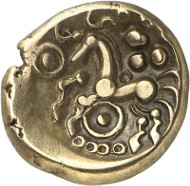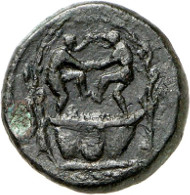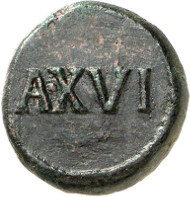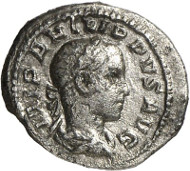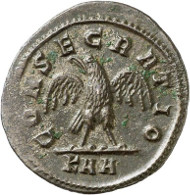15-10-2015 – 01-01-1970
Auction 40 – Ancient Coins and Art
For Advanced Collectors: Jacquier Auction 40
920 lots will come under the hammer at Auction 40 of Paul Francis Jacquier. That makes 920 opportunities for the collector to enrich his collection by rarities and exclusive pieces on October 16, 2015, starting at 4 pm. After all, the Kehl am Rhein-based auction house is specialized in numismatic rarities. This auction, therefore, features specimens that are rarely encountered on the market.
4: Celts. Eburones (Gallia Belgica). Electrum stater, after 54 BC. LT 8859. Very rare. Extremely fine. Estimate: 2,000 euros.
The sale starts with roughly 70 Celtic coins. The connoisseur not only discovers such widely known rarities as a perfect rainbow cup of the Eburones tribe (estimate: 2,000 euros) or a very fine and very rare electrum stater of the Helvetii (estimate: 3,000 euros), but also a number of büschelquinarii and other silver fractions of the Vindelici tribe, who once lived around Manching and Augsburg. The appraisals range between 60 euros and 150 euros. The coins are dated and described precisely based on the latest numismatic literature.
Nearly 100 lots of coins from the Greek world are next. When turning to bronze, the collector will find much interesting material, like a hemilitron of the Greek city of Alaisia displaying a wonderful olive-green patina (estimate: 850 euros).
199: Roman Imperial Times. Tessera, ca. 22-37. Two bearded men stomp grapes in a winepress. Cohen VIII, 266, 8. Buttrey -. Unique subject and very rare. Fine dark brown patina, good very fine. Estimate: 1,500 euros.
The catalog’s main part is dedicated to the Romans, from the coinage of the imperatores to the Late Roman period. The connoisseur will be amazed to see such great a number of extraordinary specimens assembled. Let’s start with the coins dating from the 1st century, supplemented by a small selection of tesserae and jetons.
One of the specimens whose obverse depicts two men stomping grapes makes it possible to rectify a misreading by Cohen: he mistook his poorly preserved comparative pieces for a representation of two boys playing in a bathtub.
209: Nero, 54-68. Sestertius, 67. RIC 354. Shining black brown patina. Extremely fine specimen. Estimate: 15,000 euros.
Another highlight is a collection of perfect bronze coins of the finest style. A truly remarkable piece is a sestertius of Nero struck in 67, with a depiction of the Temple of Janus on the reverse. This coin refers to Nero’s biggest success in foreign policy: he managed to negotiate a truce with the Parthians, and an envoy of the Parthians came to Rome to seal the deal on peace in an ostentatious ceremony. This ceremony included the closing of the Temple of Janus, an event which was commemorated on a series of aurei, denarii and bronze coins. With their sheer size, the bronzes are impressive representatives of this relatively unknown Neronian coinage.
But the auction offers many more examples of these magnificent bronze coins. We would like to highlight a sestertius of Agrippina Maior with a portrait which is shown in full detail (estimate: 15,000 euros), a sestertius of Domitianus with a shining black green patina (estimate: 4,000 euros), and an appealing sestertius of Marcus Aurelius depicting a heap of Germanic-Sarmatian weapons on the reverse, reminiscent of a victory over the Sarmatians (estimate: 3,000 euros).
317: Philippus II, Augustus 247-249. Quinarius, Rome, 248. RIC 231b. King 369, 6. 3rd specimen known to exist! Very fine / extremely fine. Estimate: 5,000 euros.
Another highlight of the Roman section is a collection of quinarii, including some particularly rare specimens, ranging in date from Trajan’s reign to the Tetrarchic Period. The specialized collector discovers, among other items, a quinarius of Julia Mamaea (estimate: 1,200 euros), another quinarius of Philippus II (estimate: 5,000 euros), one of Diocletian (estimate: 650 euros), and lastly, a quinarius of Maximianus Herculius (estimate: 3,000 euros).
Gold, silver, bronze – in this auction the coin aficionado will be offered every metal used in Roman times for the minting of coins, to which adds a lead medallion of Commodus, bearing a Greek inscription, that might have been produced as die pattern (estimate: 1,250 euros).
443: Nigrinianus, son of Carinus, +284. Antoninianus, Rome, autumn of 284. RIC 472. Very rare. Fine patina with a metallic color. Nearly extremely fine. Estimate: 2,500 euros.
Everybody familiar with the house Jacquier knows perfectly well with how much expertise the specimens are being assembled, notably the rarities from the reign of the barrack emperors. An almost flawless aureus of Gallienus from the Archer M. Huntington Collection, which shows a depiction of Laetitia on the reverse (estimate: 10,000 euros) might become the most expensive item of this period. Nevertheless, the real stars are the hidden rarities. To name just a few: a number of legionary coins of Gallienus, some really extremely rare coins of Postumus, of which 30 lots will cross the auction block, the antoniniani featuring special busts and unusual legends, and, last but not least, such remarkably well-preserved rarities like an antoninianus which Carinus had issued for his deceased son Nigrinianus (estimate: 2,500 euros).
528: Crispus, +326. Miliarense, Siscia, early in 326(?). C -. RIC -. Cf. RIC 449, 198 (Constantinus I) and 199 (Constantius II. Caesar). 4.10 g. Unedited, unique. Fine tin-colored toning. Extremely fine specimen. Estimate: 25,000 euros.
Having arrived at the Tetrarchic Period and the imperial house of Constantine, we would like to stress that this section comprises not only several items of interest, but also an outright numismatic sensation that is an asset likewise to numismatics as an academic discipline: an unedited unique example of a miliarense of Crispus from Siscia, that has probably been minted early in 326 (estimate: 25,000 euros).
This “missing link” provides a date for two known miliarenses of the very same reverse type for Constantine and Constantius II against the backdrop that Crispus, by order of his father, was executed in Pola / Istria in the spring of 326. Therefore, the entire emission, to which almost certainly a miliarense for Constantine II has to be added, dates to the few months prior to Crispus’ execution.
Some coins from Late Roman Times, like an almost extremely fine siliqua of Maximus, issued in Barcelona in 410-411 (estimate: 3,500 euros), and a number of coins of the Crusader states conclude this section.
595: Cameo, layered agate, white on grey, horizontally oval, 1.8×1.4×06 cm. Bust of juvenile Hercules (?) or Caracalla(?), lion skin(?) around neck. Late 2nd / early 3rd cent. AD. Estimate: 1,450 euros.
The department of ancient art follows next. It comprises a rich assemblage of gems, a small selection of fibulae in different shapes, a number of spoons and toilet utensils, and, most notably, an interesting series of Hallstatt culture weapons and tools.
As always, the catalog ends with an exquisite offer of books, providing quite a few collectors and coin dealers with the opportunity to enrich their private libraries. Or do you call the comprehensive, three volume work on Sicilian bronze coinage by author Calciati (estimate: 1,000 euros) already your own? Last but not least, we would like to emphasize that a considerable number of modern auction sale catalogs are likewise being offered for sale. These catalogs make a valuable standard reference for every collector.
The lavishly illustrated catalog may be ordered for a nominal charge of 12.50 euros at Paul-Francis Jacquier, 77694 Kehl am Rhein, Honsellstrasse 8, telephone: +49 (0)7851 / 1217, email.
Please find the auction catalog online here.



